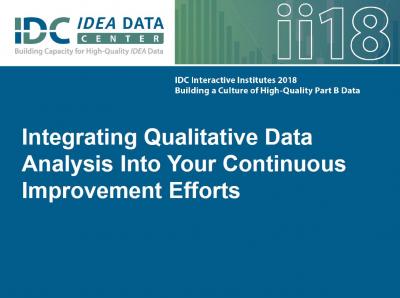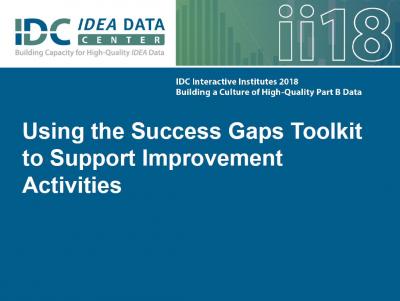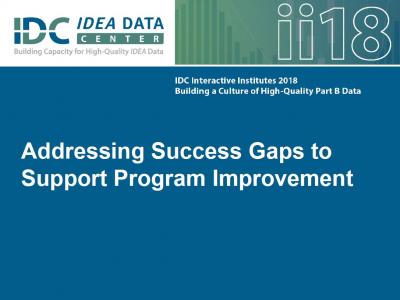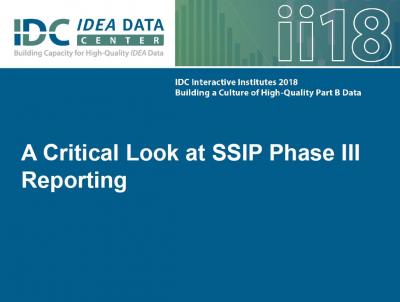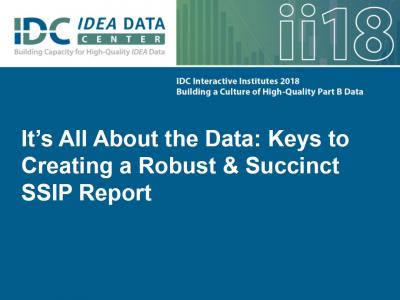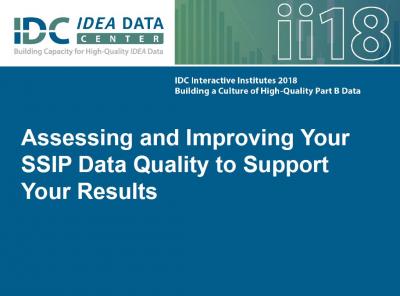Site Search
Results 15 - 21 of 30
Format: Presentations
Integrating Qualitative Data Analysis Into Your Continuous Improvement EffortsWhen used together, qualitative and quantitative data provide strong evidence for change and can better inform continuous improvement efforts. This workshop focused on ways to conduct meaningful qualitative analysis and use it effectively with quantitative analysis. Participants had the opportunity to learn more about specific approaches to qualitative analysis and how to apply those approaches to an example dataset. Presenters then asked participants to think critically about how to use both qualitative and quantitative analysis to interpret and effectively present data.
Format: Presentations
The Interplay of Qualitative and Quantitative DataThis session provided a brief overview of various types of qualitative data collection methods. Presenters provided examples of different ways states can present qualitative data. They also discussed basic strategies for using qualitative and quantitative data together to support continuous improvement and evaluation efforts in states.
Format: Presentations
Using the Success Gaps Toolkit to Support Improvement ActivitiesLEAs in all states have many improvement initiatives underway at any one time. This workshop described how state and local staff can use the Success Gaps Toolkit to align various needs assessments and improvement strategies and use the data generated to support improved results for students with diverse learning needs. One state shared how it uses the Success Gaps materials with LEAs and some of the lessons it has learned.
Format: Presentations
Addressing Success Gaps to Support Program ImprovementThis session described success gaps and a process for identifying root causes of success gaps in achievement, graduation rates, or other results. This process can help teams dig deeply into a variety of data sources to identify and develop a plan to address gaps when not all students are experiencing equitable opportunities for learning and progressing.
Format: Presentations
A Critical Look at SSIP Phase III ReportingThis workshop provided an opportunity for participants to critique and discuss sample SSIP report excerpts. Guided table discussions focused on identifying strengths and ways to improve the presentation of data for a robust and succinct SSIP. States had an opportunity to develop action steps for completing their SSIP Phase III Year 2 report.
Format: Presentations
It’s All About the Data: Keys to Creating a Robust & Succinct SSIP ReportThis session focused on OSEP’s guidance for the 2018 SSIP Phase III, Year 2 reporting. The presenters addressed the importance of data quality for assessing progress implementing the SSIP and achieving the SiMR. The presenters reviewed the updated measurement language for Indicator B17 in the state’s APR and highlighted resources available to states as they organize the SSIP submission. This presentation emphasized the importance of having, using, and understanding high-quality data to inform decisionmaking at all levels of the education system. Such informed decisionmaking is necessary to support ongoing implementation of the SSIP; justify changes to strategies, timelines, and outcomes; and help communicate the state’s SSIP activities in a robust yet succinct report.
Format: Presentations
Assessing and Improving Your SSIP Data Quality to Support Your ResultsThis workshop engaged participants in identifying data quality issues that interfere with assessing progress in SSIP implementation and improvement toward the SiMR. A facilitated discussion focused on strategies for improving data quality to support decisionmaking and achievement of results.


